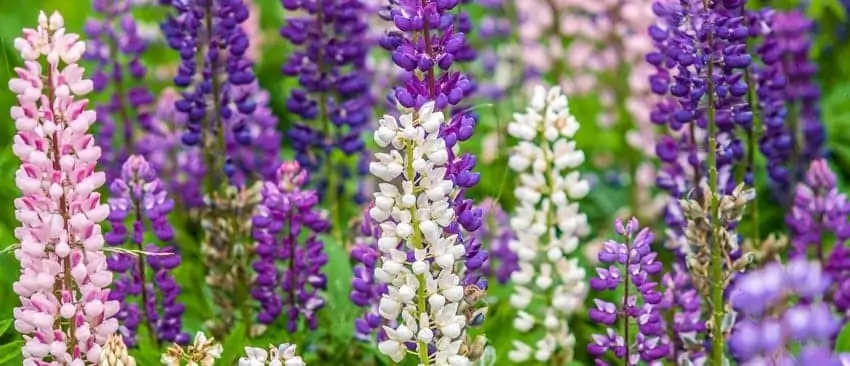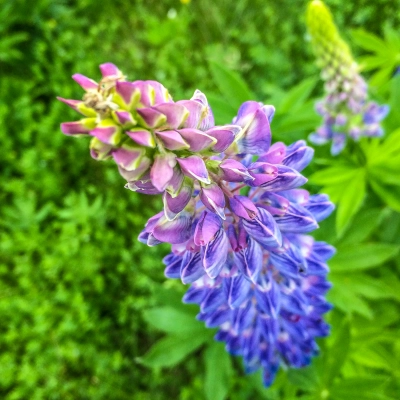Lupine, the purple, pink, and white flowers that bloom in June and July along the North Shore, are as beautiful as they are controversial. Classified as an invasive species that is not native to the North Shore, they are also a favorite amongst many who welcome their bloom at a symbol of the start of summer. Responsible management is encouraged to go hand in hand while enjoying these beautiful flowers.
 About Lupines
About Lupines
The Lupine, part of the legume family (related to peas!), is a distinct flower that displays beautiful colors during its blooming season. They draw spectators from all over the country. It is a cool weather plant that dies down from the heat of the summer and some years may not even put up a stem if the temperatures are too warm (though that is rare on the North Shore). The plant prefers well-drained, sandy soils that are fully exposed to the sun. Although there are hundreds of kinds of Lupine, Wild Lupine and Large-Leaved Lupine are most prominent along the North Shore.
The flower itself has an upper and lower portion that is typically blue/purple but can also be pink, white, and occasionally fuchsia or red. The upper and lower parts of the flower have dark veins that are forcibly opened by insects to reach their horn-shaped stamen. They typically stand around 8-18” tall and have pea-like flowers that bloom in June and July. Usually growing in bunches, these flowers will be easy to notice with their vibrant colors sticking out from the green brush typically surrounding them.
While beautiful, only Wild Lupine (Lupinus perennis) is native to the North Shore. This species isn’t as common as the Large-Leaved Lupin (Lupinus polyphyllus). These flowers are not native to the North Shore. However, the area has ideal conditions for this species to thrive in. Over the past 20 years, their presence has spread very significantly. You can see them virtually everywhere along the North Shore. So when we talk about these flowers, we are mostly referring to the Large-Leaved species, not the native Wild species.
 An Invasive Species
An Invasive Species
Unfortunately, yes, the Large-Leaved species has started taking up growing space for native wildflowers, including Wild Lupine. This is causing them to no longer grow and thrive in areas where Large-Leaved Lupine are abundant. Therefore, they are considered invasive species.
At this time, they are considered only a moderate threat. But, one problem with letting lupine thrive is that the flower and the seeds are toxic to much of the wildlife on the North Shore. Meanwhile, they are pushing out edible wildflowers that wildlife depends on for food in the spring and summer. This makes finding food more difficult for wildlife, whose population may start to suffer. Potentially, these beautiful flowers could affect the population of some beloved North Shore animals.
Lupine flowers were able to grow and thrive in northern Minnesota due to being planted in flower gardens. The hardy flowers were then spread by bees and animals as they moved about, spreading the seeds. The Minnesota DNR strongly discourages contributing to the spread of all invasive species, no matter how beautiful. Picking and planting lupine are discouraged as these actions only help spread the invasive flower further.
Despite That, Lupine Are a Popular Sight For Many
It’s hard to not love this large, beautiful, colorful flower. It’s beautiful and grows in clusters all over the North Shore. You will see plenty as you drive along Highway 61 to your destination in June and July. They especially seem to love growing in the ditches and areas along major roads as they can get more sun in these locations. They tend to bloom seemingly overnight in mid to late June, so they also symbolize the start of the summer season on the North Shore, a sight welcomed by many, especially after a long winter.
As you don’t have to hike or even walk at all to see the lupine, they are a sight that can be enjoyed by everyone visiting the North Shore. Just look out of your car window as you drive along and there they are. But enjoy the sight while they last. When the summer temperatures heat up, the lupine will go away until the next summer. During milder summers, like the summer of 2023, the lupine may stick around well into August or even September! However, you can usually expect them to go into their late-summer slumber by mid-July most years.
So, yes, they are invasive, so do not contribute to their spread. But since they are already here, don’t worry about looking at them and enjoying the beauty of this lovely flower during your next visit to the North Shore.


 About Lupines
About Lupines An Invasive Species
An Invasive Species